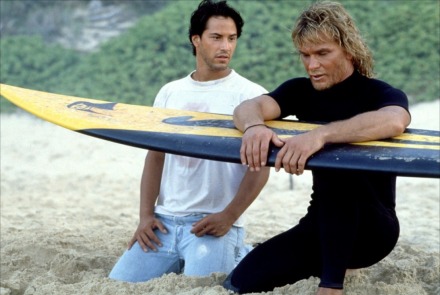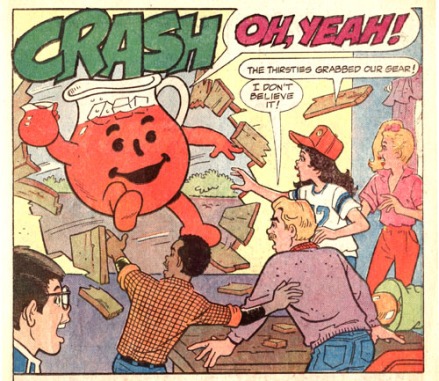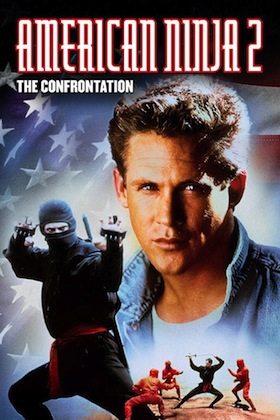Leading up to the birth of my son, I found no lack of advice on what to expect after he exploded out of my wife’s chest and scurried off to the nearest air duct to pick off the remaining crew members (I missed the birth, but I saw “Alien” for the first time and yeah, I think I got it).
There were all the usual suspects… “Oh man, enjoy sleep now! You will be sleeping much less very soon!” Or “Did you know they poop? They poop! Get used to seeing poop.” Yes friend, I’ve seen enough movie montages to know what to expect if I found myself in possession of a baby.
What I DIDN’T see coming were the myriad of closely guarded side effects of baby ownership that nobody felt the need to tell me about. Thinking about having a baby? Get ready for…
1) Constantly feeling like you just got off a boat.
Before I had a baby, the only time I’d sway while standing was if I ordered one too many pink raspberry wine spritzers at the bar my friends don’t invite me to anymore.
Then my son arrived and I stumbled upon some instinctual reflex deep in my caveman brain that caused me to rhythmically sway side to side anytime he’s in my arms.
Weave back and forth for what feels like two hundred hours a day and you’ll find it starts spilling into everything you do. Trying to discuss last night’s game with a co-worker? Let’s awkwardly maintain eye contact while I waltz in place! Trying to talk to your father-in-law about politics? Look! I’m a reed in a gentle breeze! Trying to stand in line for a Nickleback concert? No.
But the baby wobble is just the beginning…
2) Do you like singing the same song over and over and having ONE enormous bicep?
Then you’ll love having a baby.
I’ve finally found the one uncomfortable position that I can rock my son to sleep in my left arm with. For some reason I can’t replicate it on my other side because I’m not Leonardo Da Vinci or whichever ambidextrous historical figure you recognize.
I have also found that the one song my son seems to respond positively to while being rocked is the Alphabet Song.
So my life is now almost exclusively rocking the full weight of my son with my left arm as I sing him the Alphabet Song on repeat until my throat is hoarse and I start making up vowels. But I love it because he falls asleep until I try to put him down in the crib and of course he wakes up because whoever invented babies also invented the DMV and tax codes and HATES PARENTS but loves the alphabet song.
The physical stuff’s no problem though, the real draining part is…
3) Becoming hyper aware of your own horrendously fragile mortality.
I turned 31 a month after the birth of my son. Up to that point, I’d never really had any sort of existential crisis when it came to my age. That all changed when I suddenly had this rapidly developing representation of my impermanence spitting up on what used to be my only clean shirt. There is no barometer for time passing quite like a growing baby.
I watch my son play with my mom and dad and realize that my parents have already gone through this once before. I’m living the same confusing jumbled mess of raising a child that they stumbled through at my age. They took a breath and I grew up. Life kept going, whether they were ready for it or not, and now they’re grandparents. I’ll blink, they’ll be gone, and it’ll be my turn.
Every time I look at my son the whole thing plays through my head like the beginning of Up. It makes me want to smile and cry and hold him and hug my parents and kiss my wife and call my friends and tell everyone I love them but not as much as pie and then he farts and I laugh.
And then you’ll find yourself…
4) Playing the part of Marty McFly in your less awesome Back to the Future Part Whatever The Next One Is.
When I was six, my dad once let me dress up in a suit and introduced me as Batman to my kindergarten class (Yes, a suit. I was dressed as Michael Keaton’s Bruce Wayne. The nuances of secret identities were lost on 5-year-old me). It was a defining moment in my childhood, BECAUSE BATMAN.
That stuff stays with you. I’m way too old to believe I’m Batman (but maybe, right?) and here I am 26 years later reminiscing about that one time I was.
I find myself constantly trying to recreate experiences like that for my son in hopes that I’m constructing some sort of extraordinary childhood that will of course end with him as Jupiter’s galactic bio-president or whatever jobs robots let us do in 50 years. At the very least, I extrapolate my actions into the future to make sure I’m not irrevocably damaging him.
My dad bites his nails and I bite my nails, so I’m determined not to bite my nails in front of my son to prevent him from growing up with that habit. I try to avoid looking at my phone when we’re together. I read him books knowing full well he won’t remember or understand them because who knows what sticks and what won’t?
But of course, I’m terrible and check my emails on my phone while I’m feeding him and bite my nails without realizing it and watch as the non-nail-biting version of him fades from the photograph I keep in my pocket while I introduce this high school dance to Rock n’ Roll.
But looking back just makes you realize that…
5) Your parents were horribly irresponsible and OH MY GOD HOW DID THEY LET YOU DO THAT?!
When I was little, my parents would take me to a park in LA, strap roller blades to my feet and let me go off into an empty duck pond at whatever speed children travel at and maybe die or whatever. When we moved to Oregon, they’d leave me on an icy mountain with some friends and watch us head into the foggy trees on waxed fiberglass. They’d come back later and I guess just assume we were still alive and hadn’t eaten each other to stay warm or however survival skills work.
Before we had our son, I KNEW we would forever prioritize his safety. We would put him to bed on his back and never sleep with him. Sterilize his pacifier after every use. Make sure visitors washed their grubby little hands before touching him.
Then the night after getting back from the hospital I couldn’t get him to sleep so I carried him stumbling down two flights of stairs in the middle of the night to pass out on a bean bag with him on my chest.
There is a constant battle between sanity and safety that I’m finding is getting very blurry very quickly. He needs to eat dirt. We both need to sleep. He needs to share slobber coated toys with his cousins. I need to wash those toys at some point… And I start to see how this ends with me sending him down the side of a snowy mountain while I sip hot chocolate.
Easier said than done though, because you find very quickly that…
6) The world wants to eat your baby.
It didn’t take me long to realize I’m now responsible for this chubby little teacup for quite literally the rest of my life.
Suddenly, the news is full of information to be feared. Terrifying viruses, tragic shootings, Sudden Infant Death Syndrome… Articles I used to selfishly ignore because my parents weren’t old and none of us were young.
My son had a fever of over 105 degrees two weeks ago and I nearly went insane with worry until we realized we had a broken thermometer that always showed 105 degrees. 105 DEGREES. I wanted to pass out and wake up in the castle from “Beauty and the Beast” so I could beat the ever-living crap out of the thermometer in front of Cogsworth and have it mean something. I found I am wholly unprepared to love this little creature the world is determined to prove can’t survive on its own.
Luckily there won’t be many moments to think about it because…
7) You will become ultra efficient with your time.
Because you don’t have a choice.
I’m very “deadline driven”, I perform best under time-sensitive circumstances and put everything else off until it’s due. However, when you have a baby, you are perpetually 45 minutes from a deadline. In 45 minutes he has to eat. In 45 minutes he has to sleep. In 45 minutes he has to wake up. What you put off this 45 minute time slot merely cascades into a spiraling list of to-dos that will pick your life clean of free time.
For a procrastinator, that’s pretty much an optimal setting.
There is no “later” or “tomorrow”. If I don’t clean the bottles there are no bottles and Lucas won’t eat and will grow up resentful and put me in a home and I’ll have to play dice for cigarettes or maybe that’s prison. My life has become a series of fast approaching deadlines for a tiny sultan that is as demanding as he is adorable.
But don’t worry, it’s all worth it when you realize…
8) Your baby has no idea who you are and won’t care about you for MONTHS.
Having a newborn is like being infatuated with the coolest kid in high school. You smile and try to talk to them but they still have no idea who you are even though you sit right next to each other in chemistry. YOU COPIED OFF ME FOR THE ENTIRE SEMESTER. HOW DO YOU NOT KNOW WHO I AM? Also babies are great at sports.
You spend the first couple of months just trying to get your baby to acknowledge that you exist in the faintest way you can rationalize (He blinked RIGHT. AT. ME. Did you see?!). But in the end, they’re just drunk little roommates that poop everywhere and expect you to clean up after them even though they know that wasn’t in the lease.
And then one day they smile at you and EVERYTHING washes away in their toothless little grin. The heavens open and doves fly through the living room as your child looks up at you with a glimmer of recognition in those bright little laughing eyes. In that moment all the friendly advice and Internet articles and amateur blog posts just melt away and all that’s left is warmth.
Because they just peed all over you.



















































